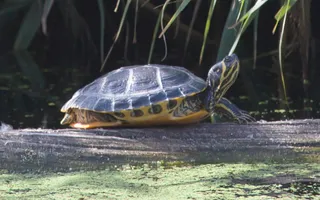Red-eared terrapin facts
Scientific name: Trachemys scripta elegans
Family: Emydidae
Diet: An opportunistic omnivore, they prey on native fish, water birds, invertebrates and amphibians including frogs.
Size: 30cm
Weight: 6lb
Lifespan: 20 years
The charity making life better by water
Making life better by water
All species of terrapin found in the UK are invasive. Red-eared terrapins were transported from the USA as pets during the 'Teenage Mutant Hero Turtles' cartoon craze of the 1980s.
Scientific name: Trachemys scripta elegans
Family: Emydidae
Diet: An opportunistic omnivore, they prey on native fish, water birds, invertebrates and amphibians including frogs.
Size: 30cm
Weight: 6lb
Lifespan: 20 years
Red-eared terrapins (also known as red-eared sliders) lost their pet appeal once owners discovered that they could grow to the size of dinner plates and develop substantial strength. This caused many to be irresponsibly released into the wild.
Terrapins, along with tortoises and turtles, are known as 'chelonians', meaning reptiles with shells. They are almost totally aquatic, but need dry land to bask on during sunny days - so a canal or river is an ideal habitat for them.
These omnivores have an appetite for plants and invertebrates, and compete with native aquatic animals like fish, frogs and waterfowl, for food and shelter. They have also been known to bask on moorhen nests, which interferes with their breeding.
Still, open waters and slow-flowing rivers in the Midlands and southern England support the largest terrapin populations.
Other invasive species, like snapper turtles and European pond terrapins, have also been spotted along our waterways.
The big clue is in their name. This species has a distinctive red stripe behind each eye, in the place you'd imagine ears to be.
Their shells are usually a dark olive green with a splash of yellow to the edges. However, if you come across a dark green terrapin with yellow features but no red eye-stripe, it will be the aptly named yellow-bellied slider.
It's unlikely that these animals are breeding in the UK, as terrapin eggs need to be incubated at 25 degrees Celsius for around 60 days in order to hatch. Anyone familiar with the British summer knows exactly how unlikely that is. However, with climate change, it's not unthinkable that this could happen in the future.
Last Edited: 7 May 2025

Sign up to our newsletter and discover how we protect canals and help nature thrive


